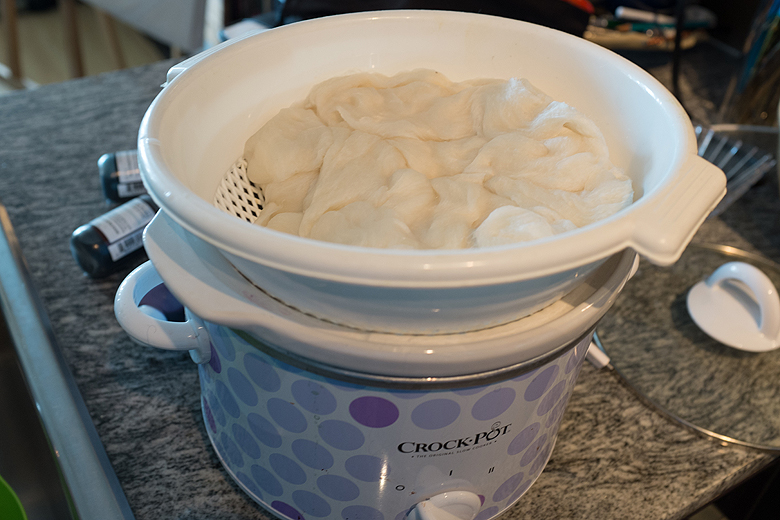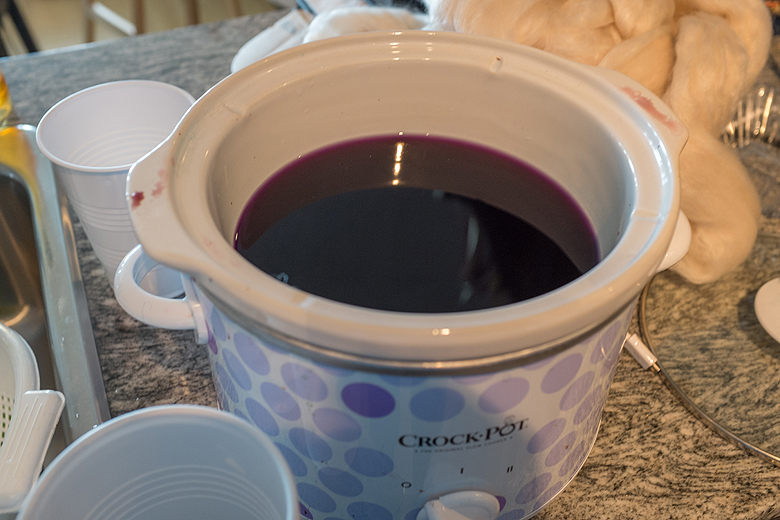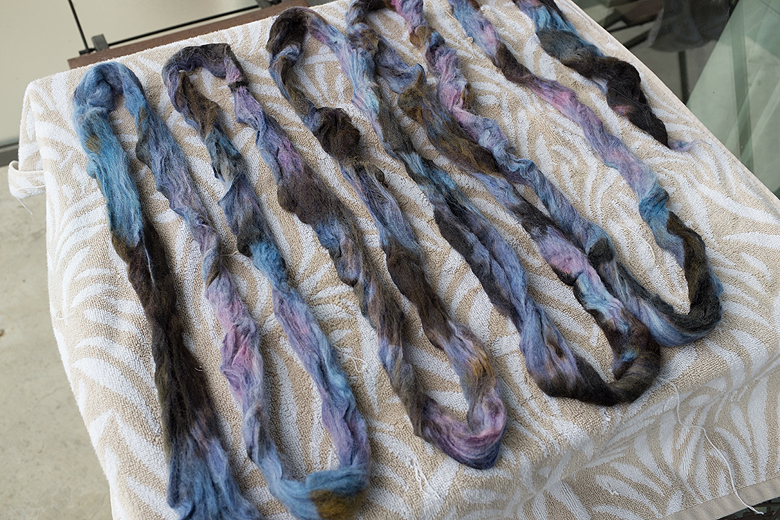Dyeing Roving, a Quasi-Tutorial
Dyeing Roving, a Quasi-Tutorial
One of the treats that I brought home from Pearl Fibre Arts was 3 bags of luxury, roving, for me to try my hand at dyeing roving myself. That would be the ultimate for me – spinning my own hand dyed yarn and then weaving/knitting with it! If I could raise the sheep in the living room, I would.
I know that some folks have had trouble with the wool felting, or failing to fluff up when dry. I’ve had pretty good results, and here’s what I did. All three of these were dyed using Jaquard Acid Dyes.
1) Superwash Panda
I knew I could be a bit more rough with this one, so it’s the only one that made it into the microwave. I wanted to try getting a colour shift across the length of the braid.
I put the roving into a soak of 1 part vinegar to 2 parts water and left it there for 30 minutes.
I filled 5 plastic cups with water and red dye, and then added 1 drop of black in the first cup, 2 in the second and so on, with 5 drops of black in the final cup.
I arranged my braid across the 5 cups, put the whole thing on a plate and popped that plate in the microwave. I kept nuking it (30 seconds at a time) until the dye bath was ‘exhausted’ (which means the water is coming out clear).
Here is my result, drying in the balcony.
… And back in a braid.
The colour is pretty, but the gradient effect is not really there. I might overdye it at one end just to get more contrast.
2) Camel/Silk
This was my first non-superwash braid, and I was really worried I’d ruin it so I did what I could to minimize handling.
First, I put it in the vinegar soak for 30 minutes. I placed a sieve over my crock pot and poured the yarn, and the soak, gently into the sieve.
With the yarn in the sieve, and the vinegar soak in the pot, I topped off the vinegar soak with enough water and vinegar that it could cover my roving, and then added dye directly to the crock pot.
When I had a colour I liked, I gently poured the yarn from the sieve into the crock pot.
To get a very slight variegation, I filled a plastic syringe with more dye and injected it directly into the wool in different areas.
I left the crock pot on until the dye bath was exhausted, and then turned it off. I let the yarn cool down on its own, and didn’t touch it.
When it was cool, I poured the entire crock pot into the sieve again, and let the yarn drain in the sink for a while (if your dye bath was exhausted, no rinsing should be needed here).
Finally, I lay it out on my balcony to finish drying.
Here is the final, dried piece, back in a braid.
3) Merino Silk
This one was done exactly as above, except that I was a little more confident with injecting extra dyes into the pot, so I was able to create a much more variegated colour. Here it is drying out:
And here it is back in a braid.
In all three cases, I lay the yarn flat to dry on my sunny, slightly windy balcony. I think this almost certainly helped it to dry faster and ‘fluff up’ a bit, rather than, say, hanging it in my bathroom.
With the 2 non-superwash braids I did my best to handle the yarn as little as possible (when I needed to turn the yarn in the dye bath I would use a silicone spatula and limit my movement to one flip of the fibre) and, just as importantly, I did not subject the yarn to any dramatic changes in temperature.
I’m very happy with the results, can’t wait to try this again! Even more… I can’t wait to actually spin one up :)















